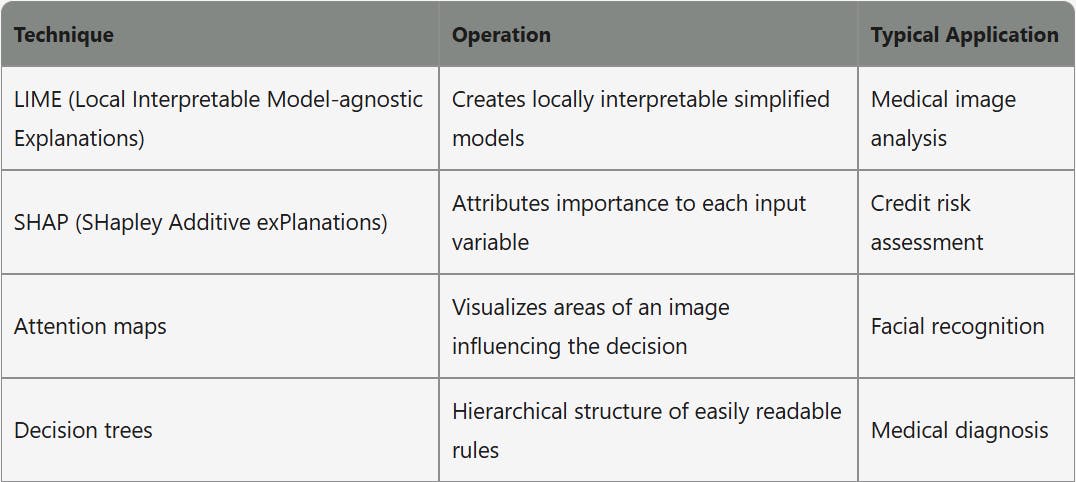
Apr 28, 2025
Table of contents :
Discover how Explainable AI (XAI) is transforming business practices in response to the EU AI Act. This article explores the challenges of algorithmic transparency, explainability techniques, and sectoral applications.
Explainable AI (XAI) is radically transforming how organizations deploy their artificial intelligence systems by making their decisions understandable and justifiable. But how can we reconcile performance and transparency in increasingly complex models? How can we meet regulatory requirements while preserving innovation? This article guides you through the challenges, technologies, and best practices of explainable AI, now essential for any responsible AI strategy.
Explainable AI represents a set of methods and techniques aimed at making the decisions of artificial intelligence systems understandable by humans. Unlike traditional approaches where the internal workings of algorithms remain opaque, XAI reveals the "why" and "how" of algorithmic predictions.
Explainable AI is based on four essential pillars:
As a EESC report highlights: "Explainability is not just a technical requirement, but an ethical imperative that conditions the social acceptability of AI."
Several technical approaches enable these explainability objectives:

These methods transform complex models like deep neural networks into systems whose decisions can be explained and understood by various stakeholders.
The European Union adopted in 2024 the world's first comprehensive regulatory framework dedicated to artificial intelligence, with strict requirements regarding the explainability of systems.
The EU AI Act categorizes AI systems according to four risk levels, each involving different obligations regarding explainability:
For high-risk systems, which concern many critical business applications, requirements include:
Companies must adhere to a precise timeline to comply with these new requirements:
This progressive implementation gives companies the necessary time to adapt their AI systems, but requires rigorous planning.
The adoption of XAI is already profoundly transforming several key sectors.
In the financial sector, explainable AI addresses critical issues:
A major European bank reduced its credit decision disputes by 30% by implementing SHAP models to explain each denial in a personalized way.
The medical field, particularly sensitive, greatly benefits from XAI:
Google DeepMind has developed eye disease detection systems using saliency maps to highlight detected abnormalities, allowing ophthalmologists to understand and validate the proposed diagnoses.
Recruitment and talent management are evolving with explainable AI:
A study shows that candidates accept job rejections 42% more favorably when a clear and personalized explanation is provided.
Effectively deploying explainable AI requires a structured approach.
The first step is to determine the required level of explainability:
Map your AI systems according to their impact:
Define audiences for explanations:
Establish explainability metrics:
Several technical approaches can be combined:
Open-source frameworks like AIX360 (IBM), InterpretML (Microsoft), or SHAP facilitate the implementation of these techniques without reinventing the wheel.
A solid governance framework is essential:
Despite its potential, explainable AI presents significant challenges.
One of the main challenges remains the balance between performance and transparency:
Hybrid approaches, combining high-performance "black-box" models with explanation layers, are emerging as compromise solutions.
Explainability does not solve all ethical problems:
A holistic approach to ethical AI must complement explainability efforts.
The prospects for evolution in the short and medium term are promising.
Several trends will shape the future of XAI:
By 2026, according to analysts:
Explainable AI is no longer an option but a strategic necessity in today's technological ecosystem. Beyond mere regulatory compliance, it represents a lever of trust and adoption for artificial intelligence systems.
For organizations, the challenge now is to integrate explainability from the design of AI systems, rather than as a superficial layer added afterward. This "explainability by design" approach is becoming the new standard of excellence in responsible AI.
In a world where trust becomes the most precious resource, explainable AI constitutes the essential bridge between algorithmic power and human acceptability. Companies that excel in this area will not only comply with regulations but will gain a decisive competitive advantage in the digital trust economy.
author

Published
March 20, 2025